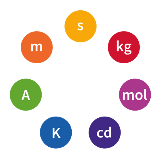Base units

There are seven mutally independent base units, from which all other physical units are derived. They are based on the definitions of some universal constants of nature, such as, among others, the speed of light in vacuum, the constants of Avogadro, Boltzmann and Planck, and the electron charge.
| unit | symbol | quantity | definition |
|---|---|---|---|
| second | s | time | ground-state hyperfine transition frequency νhf of 133Cs = 9,192,631,770 Hz *) |
| meter | m | length | speed of light c in vacuum = 299,792,458 m/s |
| kilogram | kg | mass | Planck's constant h = 6.626,070,15×10-34 J·s **) |
| ampere | A | current | electron charge e = 1.602,176,634×10-19 A·s |
| kelvin | K | temperature | Boltzmann's constant kB = 1.380,649×10-23 J/K **) |
| mole | mol | matter | Avogadro's constant NA = 6.022,140,76×1023 particles per mole |
| candela | cd | luminous intensity |
luminous intensity of radiation source with frequency of 540×1012 Hz *) emitting an energy of 1/683 J **) per second and per steradian = 1 candela |
*) 1 Hz = 1 s-1
**)
1 J = 1 kg·m2·s-2
Related concepts
| Last modified: | 10 April 2024 09.44 a.m. |
View this page in: Nederlands
